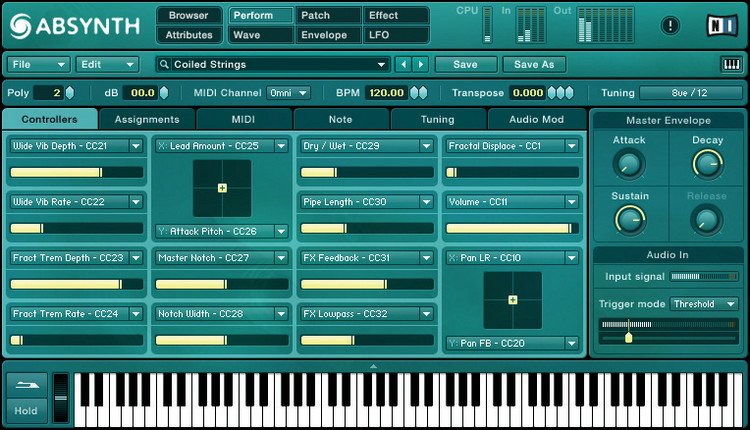
MIXING DESK and MASTER SECTION – As you can see in the images below, the mixer is pretty bare with no EQ or effect plug-ins inserted.
#Absynth 5 ambient full#
So if you layer that with Toxic’s lush, full sound you get a new layered sound that is unique and inspiring. Absynth has always excelled at soundscapes and atmospheric sounds since version 1. I use Abynth for crazy, otherworldly sounds. Toxic comes with plenty of cold digital pads, too, which I like.

Toxic is good for straightforward pad sounds, as well as bright FM pads that can pierce through the mix.
#Absynth 5 ambient generator#
Think of Toxic and Absynth as sound modules triggered by the MIDIOut generator – a virtual MIDI controller, so to speak. So needless to say, Toxic and Absynth has been set up to play the same notes and receive MIDI note messages from the generator called MIDIOut #1. It can make your track sound fuller, wider, lush and not bare. I believe great results can be had from layering synthesizers. I like layering a lot and countless producers have been practicing that process for decades. These two are just that, have been very reliable and can perform the job more than fine. In composing ambient music I think it is important, especially the pads and atmospheric parts, that you need excellent sounding and versatile synthesizers. They will be the ‘featured’ sound in my song mostly – the others are just there for backgrounds or fill-ins.
#Absynth 5 ambient software#
TOXIC AND ABSYNTH SYNTHESIZERS ARE KEY – When I mentioned above that the two main tracks are the software synthesizers, I meant to say that these two synths will be the ‘driving force’ in my song. The rest of the empty tracks are reserved for audio, into which I can bring WAV files or record audio in Orion directly using the audio tracks.ģ. The first two main tracks are software synthesizers Synapse Audio’s Toxic FM synthesizer (built-in with Orion) and the Absynth 5 synthesizer by Native Instruments. For now, the tracks are empty, but the playlist is automatically populated with an initial of 8 tracks. Now, I have basic framework to work with. PLAYLIST POPULATED – Rrather than having to go through and build it every single time, the convenience of bringing in a template will populate my playlist with tracks. If I was going to produce a trance tune, I would simply open up a saved file called “Trance Starter”.Ģ. The name describes the type of music that’s going to be produced in Orion. My template is called “Ambient Starter” simply because as the name suggests, it will be used in composing experimental, dark ambient, ambient and all sorts of drone music. But with the new version, and as you can see in the image below, the quickest way to bring in a template is to go to Insert, choose Template and left click on the file.

STARTER FILE – When I launch Orion, the first thing I used to do is go to File>Open>Ambient Starter.sfs, double click it to open up my saved template. My intention for this article is to spotlight Orion when setting up a template for ambient music. This is simply because I just want a file that is ready to go after firing up the program. I always use the same template saved on my song folder over and over again. When using Orion, my projects do not vary too much. People should practice this approach more often as it can give you a starting point, helps you become efficient, saves time without having to go through creating it every single time and just the convenience of knowing it’s there for instant recall makes producing much faster and easier. A song template basically contains anything that can be saved as a. I think we (musicians/producers) should embrace this. The ability to save blank projects and song templates is one nifty feature because it gives you a basic framework to work with. One of the best things about sequencers like Orion (or similar DAWs) nowadays is that you can customize your blank projects to your own specification. Not to mention the program is affordable and super easy to use. In the early 2000’s when I was introduced to this software studio by my friend, I was just blown away with the sheer quality of the built-in effects, synthesizers, drum machines and other generators it offers. I have to admit that I’ve always liked this software since it first came out. Synapse Audio’s Orion started out as pattern-based sequencer, but over the years has morphed into capable, powerful music creation software.

This article shows how this can be accomplished. Users of Synapse Audio’s Orion software have an opportunity to make their work far more efficient.


 0 kommentar(er)
0 kommentar(er)
